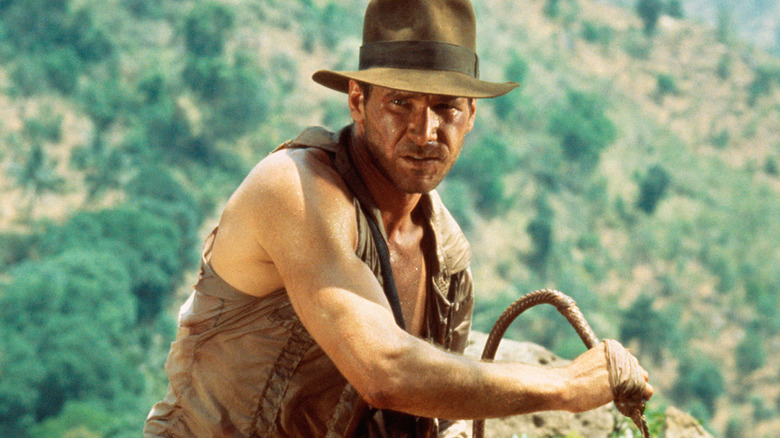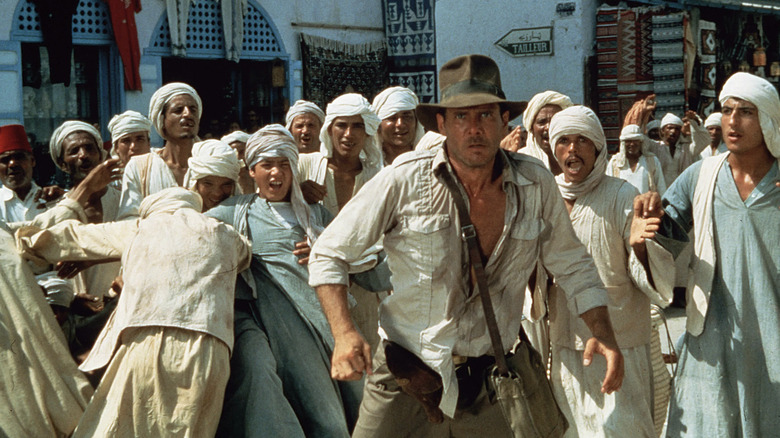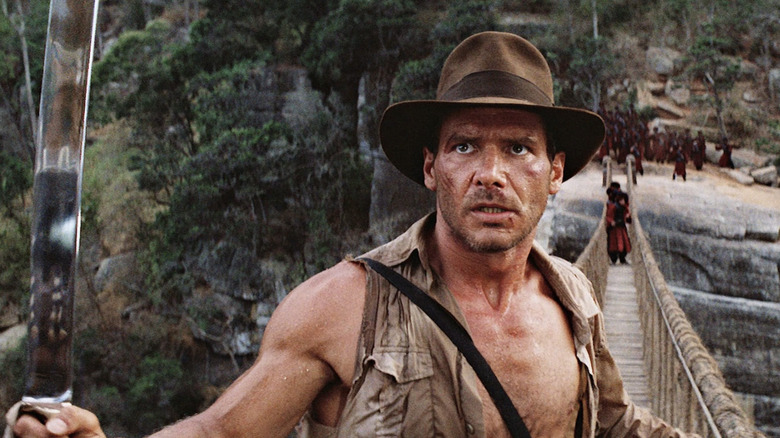
Nothing transforms a memorable character into a timeless icon like a truly exceptional costume. Over the years, Harrison Ford has donned more than a few: from the brown overcoat he wears as Rick Deckard in "Blade Runner" to the black vest and white henley combo of Han Solo. But there's one outfit that's perhaps more instantly recognizable than both — if only because one really needs only its silhouette to identify it — and that's Indiana Jones.
At a glance, Ford's costume for the character carries an air of minimalism similar to his other roles. A semi-casual button-up shirt, a leather jacket, and a pair of pants all done up in varying hues of brown and khaki. On paper, it all sounds rather bland, which it might've been had Indy remained at the university and wasn't a globe-trotting adventurer. But what really set the costume apart were two crucial accessories: his whip and a fedora that had no business being so ruggedly stylish. But don't let the relative simplicity of Ford's costume in the movie fool you into thinking maintaining his wardrobe throughout filming was an easy task.
Doubles, No, Triples — Triples Of Every Outfit Is Safe

Throughout pretty much every film that he appears in, Indiana Jones can be seen wearing his traditional outfit, with only a few exceptions like when he's in disguise or being held captive. As a result, he doesn't exactly have very many elaborate costumes. While this might create the impression that the wardrobe department had an easy, breezy time when it came to dressing Harrison Ford, this is far from true. According to Anthony Powell in an interview with From Director Steven Spielberg, the wardrobe designer for "Temple of Doom" revealed just how difficult it really was:
"To the public, Indy wears an old shirt and an old pair of pants, but they don't realize how much is involved and how expensive it all is. For a start, you need six of everything because what clothes have to go through on an action picture is phenomenal. Every time Harrison falls down a ravine or jumps in a river, he will need a change of costume."
Given how often that happens in pretty much every single film — not even counting the necessity of multiple takes and doubles like stuntmen — that's a seriously massive backup wardrobe. Powell said that just for "Temple of Doom" they needed to create thirty shirts for Ford's character. Yet perhaps what's even more remarkable, as he pointed out, is that it "doesn't show on the screen at all." I count it as a testament to the skill of Powell's team (and not my own naivety over the immense challenges of wardrobing films) that I actually thought it was just the same outfit being used throughout the whole movie. But that's the magic of films for you!
Filming Wear And Tear In Reverse

Given the nature of Indy's exploits, his clothes never stay pristine for long. On set, that meant wardrobe needed to meticulously show wear and tear across his many outfits chronologically. But films are rarely made that way, as Powell explained to From Director Steven Spielberg. Working backward, they created his most beat-up outfit first and then scaled back the damage in accordance with what happens to him on screen. "By the end of the movie, Harrison's costume has to look like he's crawled through jungles, fallen down mines, and fought his way to hell and back," he said.
But making clothes look like they've been the go-to outfit for a decade of an archeology professor who thwarts Nazi plots on the side is also quite expensive. "The cost of aging clothes artificially can be much more than the cost of making them in the first place," Powell said. "There are a million tricks of the trade involved: staining, bleaching, washing, dyeing, sandpapering. It's very hard work!" Interestingly enough, when costume designer Deborah Landis ("Raiders of the Lost Ark") brought to life the concept she and George Lucas had developed, she also used such tricks to quickly age his hat.
"He had to look like he had been wearing these new clothes for his entire life — slept in them, worked in them, that they had been sweated through and they were his second skin," she told The Ringer. Which is good enough proof as any that the tireless and affectionate attention to detail that costume designers put into their work is never in vain — if the clothes make the man then it's the wardrobe department that make such movie icons possible.
Read this next: The 18 Best Action Movie Actors Ranked
The post Dressing Harrison Ford For Indiana Jones Wasn't As Simple As It Might Seem appeared first on /Film.
0 Comments